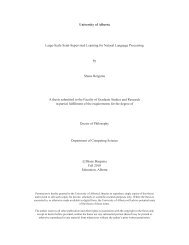The high altitude wildlife areas of western Arunachal Pradesh
The high altitude wildlife areas of western Arunachal Pradesh
The high altitude wildlife areas of western Arunachal Pradesh
Create successful ePaper yourself
Turn your PDF publications into a flip-book with our unique Google optimized e-Paper software.
Introduction<br />
Chapter 1<br />
A biological expedition in the <strong>high</strong> <strong>altitude</strong>s <strong>of</strong> Western <strong>Arunachal</strong><br />
<strong>Pradesh</strong>, Eastern Himalaya<br />
Introduction<br />
A rich diversity <strong>of</strong> life<br />
<strong>The</strong> state <strong>of</strong> <strong>Arunachal</strong> <strong>Pradesh</strong> in northeast India is uniquely situated in the<br />
transition zone between the Himalayan and Indo-Burmese regions (26°28'– 29°30'N<br />
and 91°30'– 97°30'E; 83,743 km²; Fig. 1) 1,2 . <strong>Arunachal</strong> is located within the Eastern<br />
Himalaya global biodiversity hotspot 3 and is also among the 200 globally important<br />
ecoregions 4 . <strong>The</strong> state harbours the world’s northernmost tropical rainforests and is<br />
estimated to have nearly 50 % <strong>of</strong> the total flowering plant species in India 5-8 . Of the<br />
1200 bird species in India, nearly 600 have been recorded from the state 9 , which is also<br />
recognized as an important endemic bird area 10 . <strong>Arunachal</strong> is also home to fascinating<br />
species <strong>of</strong> large herbivores such as the takin Budorcas taxicolor, goral Nemorhaedus<br />
goral, and serow Nemorhaedus sumatraensis, several species <strong>of</strong> primates, and<br />
carnivores such as the common leopard Panthera pardus, clouded leopard Ne<strong>of</strong>elis<br />
nebulosa, and tiger Panthera tigris.<br />
<strong>The</strong> wide altitudinal range (100 m to over 6000 m) within <strong>Arunachal</strong> has<br />
brought about a great diversity <strong>of</strong> habitat and forest types, and a rich diversity <strong>of</strong><br />
animal and plant life. Lowland tropical evergreen and semi-evergreen forests occur up<br />
to 1500 m, temperate oak and conifer forests up to 3500 m, and alpine <strong>areas</strong> above<br />
3500 m. Large <strong>areas</strong> <strong>of</strong> forest still remain in the state, in part due to its low human<br />
population density (13 per km 2 ) 11 . Although <strong>Arunachal</strong> has the lowest human density<br />
compared to other Indian states, its decadal growth rate (1991-2001) <strong>of</strong> 26% is <strong>high</strong>er<br />
Fig. 1. Map <strong>of</strong> <strong>Arunachal</strong> <strong>Pradesh</strong>, north-east India. Hatched regions represent protected <strong>areas</strong>. <strong>The</strong> <strong>high</strong> <strong>altitude</strong><br />
region (> 3000 m) <strong>of</strong> the state is shaded gray. Note the near absence <strong>of</strong> protected <strong>areas</strong> in the <strong>high</strong> <strong>altitude</strong>s. 1.<br />
Eagle’s Nest Wildlife Sanctuary 2. Sessa Orchid Sanctuary 3. Pakhui WS 4. Itanagar WS 5. Kane WS 6. Yordi Rabe<br />
Supse WS 7. Mouling National Park 8. Dihang Dibang Biosphere Reserve 9. D’Ering WS 10. Mehao WS 11. Kamlang<br />
WS 12. Namdapha NP.<br />
1

















